Everybody Must Get Stoned…
Peoples State Forest Nature Museum, Barkhamsted (Google Maps Location)
September 2007
Connecticut museum visit #30
Yes, even little Damian.
When I visited, this place was called The Stone Museum but was re-named The Peoples State Forest Nature Museum, which was its original name.
Calm down, people. I’m talking about visiting the Stone Museum in the Pleasant Valley section of Barkhamsted! I remember when I was pulling together my ridiculously long list of Connecticut museums sort of stumbling over the one called “The Stone Museum.” Was it a museum filled with various stones and rocks? Makes sense, doesn’t it? We decided to find out via a stunning drive across north-central CT after visiting the coolest tree in the state in Granby.
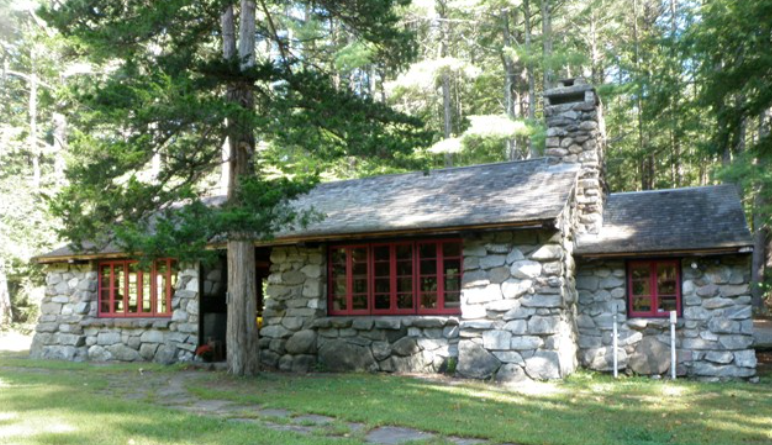
My pre-supposition about a room filled with rocks was wrong – and perhaps why they changed the name after our visit. The Stone Museum is a natural history museum and was built in 1934 by the Civilian Conservation Corps (CCC) as a museum for Camp White and for the people of the state. From what I’ve gathered in my hikes here and across the river in the American Legion State Forest, the CCC seems to revel in stonework – buildings, bridges, waterbars, walls, hillside stairways…
The outside of the building and the fireplace are local field stone taken from old stone walls. All inside woodwork is American chestnut which was salvaged from the trees killed by the chestnut blight. Ironwork was produced by the Camp White blacksmith. The building architect was Robert Linehard, carpenter was Robert Loughlin, and the mason was August Casciani.
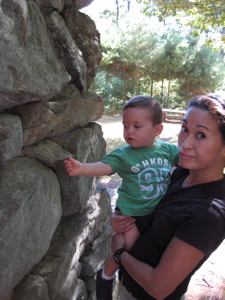
They did a very good job, as I think the place has a rustic beauty all its own. The museum exhibits mounted taxidermy specimens of many mammals and birds that are common in the forests here, as well as samples of twigs, bark and wood of local trees.
Display cases in the museum contain artifacts from Indian and colonial sites in the area, and describe the early iron industry when northwestern Connecticut was among the world’s leading producers of iron. The forges and blast furnaces were fueled by charcoal which was produced in local forests from 1734 to 1923.
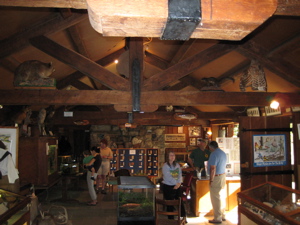
We picnicked down near the river in Matthies Grove. As I’ve learned, every trail, rock, quarry, and grove bears the name of an important person from CT’s past. On August 2, 1929 the Matthies family of Seymour purchased the 210-acre Ullmann farm, including the house, barns, and outbuildings. In a special dedication ceremony, Governor John H. Trumbull received the deed for the Ullmann farm from the Matthies family – the largest single donation to People’s State Forest. The ceremony took place in the beautiful pine grove along the Farmington River, which today carries the Matthies name.
The Stone Museum is a short jog away – and worth the visit. We entered and Damian immediately started pointing to the animals on display. Notably, the kitty-cat:
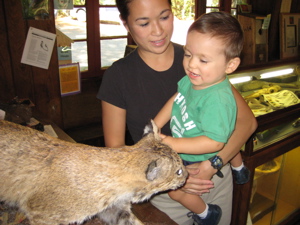
He also enjoyed the skunky-skunk:
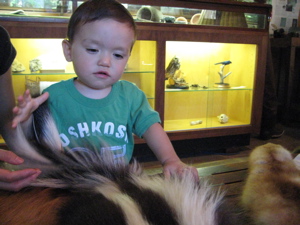
Also on display were several pelts from beavers (the softness surprised Hoang), deer, and various other woodland creatures. As mentioned, the museum also has some good educational exhibits about such things as the tree species one would find in local forests:
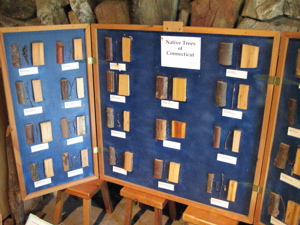
Good to know. The logging industry has certainly had an impact in the local area – and continues “smart logging” today. What follows is a study in how long a little kid enjoys sitting on a cross-section of a tree:
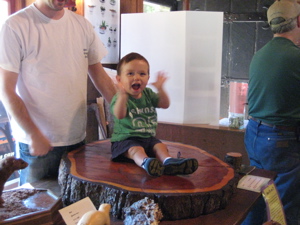
42 seconds: “Yipee!”
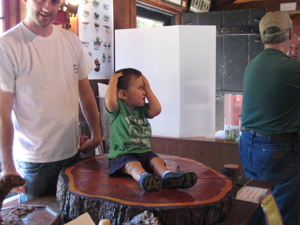
1 minute, 7 seconds: “Yeah, okay, it’s a tree.”
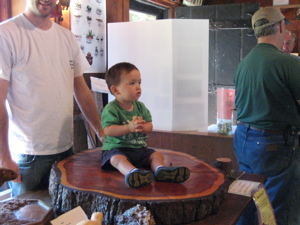
1 minute, 36 seconds: “Oh come on Papa, get me down!”
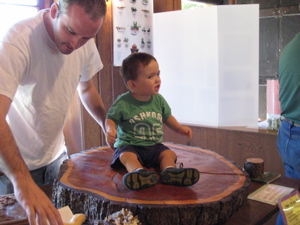
2 minutes, 2 seconds: “I said, GET ME DOWN!”
Phew, we dodged that bullet. Say, let’s check out some of the local history of the area, via the museum’s three dioramas showing events in the history of Peoples Forest.
In the 1930s, 250 men occupied Camp White, a Civilian Conservation Corp camp. Some of the projects of the camp were building the museum, trails, and roads in the forest, and planting many of our forest trees. The layout of Camp White is illustrated in this diorama:
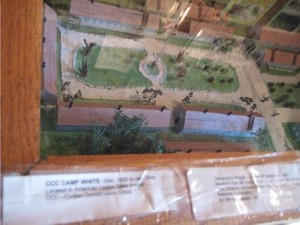
The Barkhamsted Lighthouse, a community of Indians, blacks and whites who lived in the area from 1778 to 1860, is depicted in another diorama. This site has been excavated by Central Connecticut University and the results of the study were published in a book by Kenneth Fedor, available at the museum. Of course I visited the Barkhamsted Lighthouse as well. Anyway, here’s the museum’s take on what the settlement looked like back in the day:

Native American activities at the soapstone quarry in the forest are depicted in a third diorama – soapstone bowls were an important part of the indigenous culture for about 2,000 years, starting around 4,000 years ago.
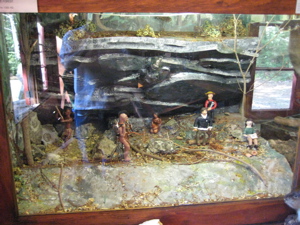
Of course, I would certainly have to visit this soapstone quarry to check it out for myself. So a couple weeks later, during an extensive hike covering the network of Peoples Forest trails, I did just that, via the Walt Landgraf Trail:
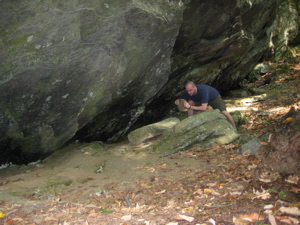
I wasn’t quite satisfied with just the dioramas, so I was happy to see that on exhibit are also a wide range of Indian artifacts, including soapstone and Indian pottery bowls, arrowheads and other weapons and tools and decorative art from the local forest area. As interesting as all this stuff was, let’s be honest… When you’re with a toddler, you’re there for the animals – even if they’re dead.
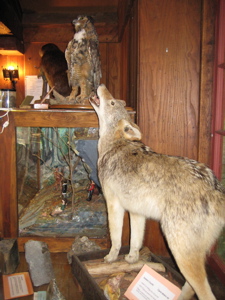
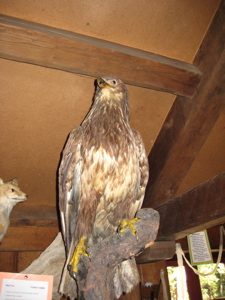
Like the above coyote and juvenile bald eagle, two residents of the area. Once again (like the “kitty-cat above), Damian enjoyed petting the “doggie.” Is that bad parenting? What about teaching him that black bears are cute and cuddly fun-loving friends who like to lend a paw to a father who’s tired of holding his plump little kid?
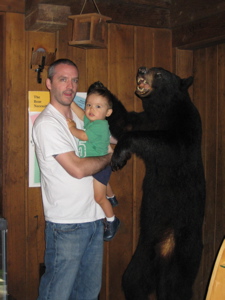
I let Damian roam alone for a while as I took in the remaining exhibits myself. The area out there in Barkhamsted (I haven’t even mentioned the massive reservoir in any of my Barkhamsted reports – and that’s really pretty too) is definitely cool and worth checking out. The woods are as pristine as you’ll find in southern New England and the local flavor is unique and very available.
I’ll end this page with a one-question quiz… What the heck is this? Not only what kind of animal, but what is the actual thing?
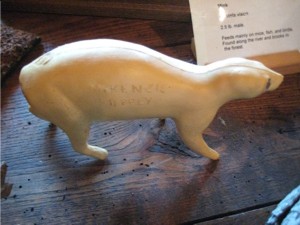
![]()
People’s State Forest Nature Museum
DEEP’s American Legion and Peoples State Forests
CTMQ’s Peoples State Forest Overview Page
CTMQ’s Museum Visits

 honeybunny says
honeybunny says
November 18, 2007 at 12:11 pmYou won’t like it if: You thought my title meant something else…yea. that was me.
I should have suspected that it wasn’t when you mentioned the Damian appearance!
hb
 Rob says
Rob says
March 16, 2009 at 1:56 pmHi Steve,
I’m not 100% sure, but I think the “whatzit” in the photograph is a taxidermist’s form. The tanned skin would be affixed to the form. Looks like it might be for a squirel or a skunk.
 Steve says
Steve says
March 17, 2009 at 7:11 amYup! It’s been nearly 2 years, but Rob is correct. I can’t remember which animal it was, exactly, but I think it was a mink or fisher.
 Kerri says
Kerri says
April 14, 2009 at 12:45 pmMy guess was going to be a polar bear-weasel hybrid.
 Julie says
Julie says
May 27, 2010 at 5:24 pmIt’s not the Stone Museum anymore. The name has been changed back to what it originally was, The Peoples State Forest Nature Museum. Exhibits have changed as well.
 Steve says
Steve says
September 10, 2010 at 3:36 pmThanks Julie, I’ve made note of the name change.
As for changing exhibits, I always assume that’s more or less understood by the CTMQ-reading public.
 cindy says
cindy says
July 3, 2011 at 4:31 pmWe visited the museum today and enjoyed it. It’s a real treasure trove of native critters (e.g. moose feet and antlers, stuffed minks, casts of animal tracks), plants, and minerals. I really wish they had a book store where I could buy a copy of every informational poster they have on the walls. Good stuff.
 Bill says
Bill says
March 8, 2012 at 3:42 pmThe website has expired, along with the name change, I guess. But is there a new website? Is the museum still operating?
 Steve says
Steve says
March 9, 2012 at 10:21 amKeep in mind it’s a state run thing, so they’ll catch up with the website by next year maybe.
as far as I know, it’s still open.
 Kristin says
Kristin says
July 28, 2013 at 3:13 pmI was just there today and saw it was open. Also, as a bonus, a heavily tagged small black bear crossed our path. Was a great added bonus for sure.